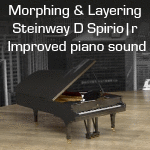 |
Welcome to the Piano World Piano Forums
Over 3 million posts about pianos, digital pianos, and all types of keyboard instruments
Join the World's Largest Community of Piano Lovers
(it's free)
It's Fun to Play the Piano ... Please Pass It On!
|
|
|
|
36 members (jinorden, Beowulf, avss01, Fer15, Frédéric L, Calavera, Greta99, AndrewJCW, 7 invisible),
460
guests, and
484
robots. |
|
Key:
Admin,
Global Mod,
Mod
|
|
 Unison Tuning Stability?
|
Joined: Jun 2005
Posts: 688
500 Post Club Member
|
OP

500 Post Club Member
Joined: Jun 2005
Posts: 688 |
I have a regular tuner/tech now, but whenever any of the six people who have tuned my piano, including my current regular tuner, a dozen of the unisons go out of tune 10 minutes after the tuner leaves. No matter who it is, no matter what. These tuners have all been the local best tuners by reputation.
But then I go and fix the unisons myself, and then they stay in tune for many months without further issue.
How can someone like me, who is NOT a tuner by any means, get the unisons to stay for months, yet these professionals cannot get them to stay for 10 minutes? I am so confused.
The only thing I can think of is that whenever these tuners tune the piano, they play the notes at a "normal" volume. I have researched, though, that you should play the notes very loudly when tuning so that they settle-in across the apex(?). I also remember that my tuner growing up, who was a local legend but now retired, would play the notes as loudly as he possibly could while tuning. It gave me a headache, but my then-piano stayed in tune for months.
So, I am just wondering what could be going on here. Am I just more "in-tune" with my piano (pun totally intended), or are tuners getting lazier these days (which I really doubt), or why do none of them not play notes very loudly when tuning?
My piano is the 2017 Charles Walter 1500 Studio, and I was told by a tuner that these are easy to tune and stay in tune with itself for very long periods, so it's dangerous in that people let them go too long between tunings because they sound in tune the entire time. I do not have this experience, ha!
When asked why I tune my own unisons with success but I don't tune my entire piano myself, it's because I can't get intervals correct. I have demonstrated for tuners, and they say that I get hung up on the wrong overtones and false beats.
I am curious what a much wider base of tuners have to say on the subject!
|
|
|
 Re: Unison Tuning Stability?
|
Joined: Jun 2011
Posts: 2,974
2000 Post Club Member
|

2000 Post Club Member
Joined: Jun 2011
Posts: 2,974 |
I dare only suggest that the reason for the "fast running" tones in the chorus is part lost frictionof one from paired pins with wood pinblock. When the tuner leaves you, one pin of the paired string loses its rigidity, but the other holds, as it has sufficient friction there. You again force the lost pin to "stand" in the right state position.
|
|
|
 Re: Unison Tuning Stability?
|
Joined: Jan 2004
Posts: 2,192
2000 Post Club Member
|

2000 Post Club Member
Joined: Jan 2004
Posts: 2,192 |
There are piano-specific electronic tuning devices that could help you with finding more appropriate targets for you to firmly set the unisons - that way you can just do it yourself...
Some can be used to "save" an aural tuning to replicate at a later time if that is your concern, but honestly, most will equal or best the vast majority of aural tunings that get placed on pianos.
Other piano owners have taken this route and been pleased with the results.
The most affordable options are PiaTune, PianoMeter and Tunelab - all are in use by professional piano techs.
Ron Koval
|
|
|
 Re: Unison Tuning Stability?
|
Joined: Jan 2004
Posts: 2,192
2000 Post Club Member
|

2000 Post Club Member
Joined: Jan 2004
Posts: 2,192 |
Otherwise, make sure to mention your concerns to the tech and let him know the past issues you have had with unisons going out.
Do you 'bang in' when you touch-up the unisons?
Do you play loudly when practicing?
These are both things that any tech should know when approaching this type of situation.
Ron Koval
|
|
|
 Re: Unison Tuning Stability?
|
Joined: Feb 2017
Posts: 3,668
3000 Post Club Member
|

3000 Post Club Member
Joined: Feb 2017
Posts: 3,668 |
Without having a good recording of:
1) Right when the tuner is done
2) 10 min later (and maybe a sample of music played in between
3) After you have retuned
then it is difficult to make an accurate assessment of the situation.
Manipulating the tuning pin and hammer is not rocket science. Some people (like yourself) pick it up very quickly, understanding the balancing act going on between pin/string/bearings. With some training maybe you can do the whole thing...? Others have.
Peter Grey Piano Doctor
Last edited by P W Grey; 01/04/21 10:30 AM.
|
|
|
 Re: Unison Tuning Stability?
|
Joined: Nov 2008
Posts: 6,253
6000 Post Club Member
|

6000 Post Club Member
Joined: Nov 2008
Posts: 6,253 |
S.S. - I have a Charles Walter console and I find it very difficult to get stable unisons. The next day after tuning I find some strings have drifted. Not a whole lot, but enough to not have all the unisons sound clean. Usually after touching them up they will stay at pitch. The problem, I believe, is a "rendering" problem, making it difficult to "set the pin". It has to do with knowing how much tension is in the nonspeaking length of the string. Quite a while ago I eased up on the pressure bar to reduce this rendering challenge. I am going to guess your piano has the same challenging rendering. You, apparently, are good at setting the pins on this piano.
Jeff Deutschle
Part-Time Tuner
Who taught the first chicken how to peck?
|
|
|
 Re: Unison Tuning Stability?
|
Joined: Feb 2017
Posts: 3,668
3000 Post Club Member
|

3000 Post Club Member
Joined: Feb 2017
Posts: 3,668 |
Can you post a recording of the unisons as you like them?
Peter Grey Piano Doctor
|
|
|
 Re: Unison Tuning Stability?
|
Joined: Sep 2004
Posts: 2,580
2000 Post Club Member
|

2000 Post Club Member
Joined: Sep 2004
Posts: 2,580 |
Here’s another thought:
I’d be curious to know if the strings that go out of tune slightly are either the left or right strings of the trichord?? Leaving the other two strings in tune.
Besides rendering difficulties I have a theory about bridge roll as the motion of the bridge when the soundboard assembly moves slightly because of environmental conditions is not necessarily straight up or down.
RPT
PTG Member
|
|
|
 Re: Unison Tuning Stability?
|
Joined: Jun 2005
Posts: 688
500 Post Club Member
|
OP

500 Post Club Member
Joined: Jun 2005
Posts: 688 |
I will try to grab the questions all at once here. First, when I refer to my tech, I am referring to everyone who has touched my piano, even Charles Walter-only techs from the dealer. I am NOT singling out my own tech. He has gone way over and beyond for me many, many times when no one from the dealer would. I am sure he reads these forums from time to time, and I want to make that clear that I am not singling him out whatsoever. I have been wanting to tune and service my own piano since I was 13 years old, but the tech I had at the time (that legendary, local best in the 1990s) told me I would need to be an apprentice, and no tech in their right mind would take on an apprentice, so that was the end of that. It ruined me forever (I am 42 now). Ever since getting the new piano in 2017, my wife is miffed that I don't learn to tune it and service it myself. All of you are encouraging me to maybe take the plunge and try. Even my own tuner asks me why the heck I don't do it myself (not in a mean/sarcastic way), since he sees what I do between visits and he has no issue with me touching my piano (I do a few more things than tweak the unisons). I just don't know where to start. I can't afford to go to piano tuning classes. By "bang-in" do you mean raise the note then bang really hard until it falls into tune? I do NOT do that; rather I just play the note as loudly as I can while I tune it, raise beyond the pitch, then ease pressure on the tuning wrench until I get the very distinct sound of strings coming into unison--the BEST sound in the entire universe, by the way. (I know a lot of people are actually twisting pins rather than turning them, which is why the notes fall when they let go, so I am very careful to not be doing that.) I can feel the pin when it is set correctly. I will also do it two, three, ten, fifteen times until it is perfect and stays that way. Then I move on to another note. I do practice VERY hard, but I was a full-time pro pianist for a long time doing a lot of very modern music with instrumentalists and ensembles, requiring an abrasive style.  I can hear the strings go out as I practice just after the tuner leaves, BUT when I touch them up myself and keep practicing hard, the notes STAY in tune no matter how hard I play. My tuner knows that I practice very hard. Why do they go out when I play hard when he (or anyone else) tunes it, but they don't go out when I play very hard when I do it? I NEVER need to touch up a unison between tunings that I tweaked myself. When I tweak the unisons, I use the center string as a reference because I don't have any way to make sure the octaves are stretched and such. It is ALWAYS the right string that goes out. Rarely, but not never, is it the left string also. Sometimes I will tune the unison perfectly, but it is waaay off compared to the octaves nearby, so then I will start over by tuning the middle string to another octave until it "sounds good", then I will match the other two strings. I can, apparently, hear notes that are as little as 3 (three) cents off. I know this isn't supposed to be possible, but I did an ear test at the Mayo for something else, and I even heard pitches above "normal" human hearing, so I wouldn't doubt it. Therefore, if you told me how much to stretch an octave, I wouldn't even know--I would just do it until it sounds great, thus probably messing up everything else in between, which is why I haven't done it on my own yet. Regarding these apps for tuning, do you literally tell it "I want A440 in regular temperament" and it just goes through all the strings with you? My tuner uses an app for the center octave, then he does the rest of the piano by ear using 7th chords. But his unisons only last 10 minutes (as does everyone else, so I know it's not HIM). That being said, I did have a dealer send me a guy to tune it who wasn't from my city; he was passing through and was told by the dealer to stop by my house. He said he couldn't use an app to tune my piano--he said he had to let the piano tell him how to tune it. It was a great tuning. Unisons still went out, but it was the most in-tune the piano ever had been. I haven't seen that tech since as he isn't from here. I will bring up the pressure bar thing with my tech. I did some research, and I am certainly not going to touch THAT with a ten foot pole as I don't have experience there. The pinblock on this piano is weird. The pins don't turn smoothly. They click around as though there are preset detents. My tuner knows this, but if I can find the right "spot" to get a good unison, why can't a 30+year pro? I can try to post a recording of myself getting a unison in tune, but my microphones never sound perfect. I can have a perfect unison, but the microphones pic up all the false crap that Walters can be known for, so it still sounds out of tune. But I can try. Nothing to lose by trying.
|
|
|
 Re: Unison Tuning Stability?
|
Joined: May 2013
Posts: 2,756
2000 Post Club Member
|

2000 Post Club Member
Joined: May 2013
Posts: 2,756 |
Perhaps you will do what I did six years ago which was to learn to tune my own pianos. It was a long process even using an electronic tuning device. It was proper use of the tuning lever and awareness of how partials interact to produce beats that led to success. I received generous great support from many in this group once I told them that I would not be taking away any of their business. For what its worth I do not use the hard blow method to produce stability. I prefer to adjust the tension in the string speaking length and the higher tension in the non speaking length such that a hard blow during playing does not result in the tuning to drop. To achieve this there must be sufficient friction at the agrafe or pressure bar.
Ian
I'm all keyed up
2016 Blüthner Model A
|
|
|
 Re: Unison Tuning Stability?
|
Joined: Jun 2005
Posts: 688
500 Post Club Member
|
OP

500 Post Club Member
Joined: Jun 2005
Posts: 688 |
I prefer to adjust the tension in the string speaking length and the higher tension in the non speaking length such that a hard blow during playing does not result in the tuning to drop. Can you elaborate on this? Are you doing more than just using the tuning pin, then, or is it the way you are setting the pin and striking the note that you are adjusting both the speaking portion and higher tension portion of the string?
|
|
|
 Re: Unison Tuning Stability?
|
Joined: Jan 2004
Posts: 2,192
2000 Post Club Member
|

2000 Post Club Member
Joined: Jan 2004
Posts: 2,192 |
Yes, the piano-specific apps are pretty easy to get up and running. They all gather information from different amounts of notes to then crunch the numbers and calculate a tuning. Many have plenty of customization to allow you to stretch more or less than where the generic built-in style begins. All will begin with equal temperament, but allow for a variety of temperaments if you prefer - from a hardly any change to huge differences in temperament.
It is pretty common for techs to not use these to the full abilities - like you mention someone just using one to set the temperament octave...
There was an owner of player pianos that learned to tune his own pianos using electronic tuning devices - he has since died, but if you search "grandpianoman" there should be threads with recordings of his success at learning to tune.
Ron Koval
|
|
|
 Re: Unison Tuning Stability?
|
Joined: Nov 2008
Posts: 6,253
6000 Post Club Member
|

6000 Post Club Member
Joined: Nov 2008
Posts: 6,253 |
S.S. The right hand string has the shortest nonspeaking length and so the final position of the pin is more critical than the others, and there is also less to work with when rendering. As far as why your tuners do not do what you do, estimate how long it takes you to get just one string right and then multiply by 250.  I remember back when Nixon was president looking for an apprentice position in a major city. Couldn't find one so I took private lessons from a blind floor tuner during his lunch hour at the biggest piano dealer in town. You might find a similar situation. 
Jeff Deutschle
Part-Time Tuner
Who taught the first chicken how to peck?
|
|
|
 Re: Unison Tuning Stability?
|
Joined: Jun 2005
Posts: 688
500 Post Club Member
|
OP

500 Post Club Member
Joined: Jun 2005
Posts: 688 |
As far as why your tuners do not do what you do, estimate how long it takes you to get just one string right and then multiply by 250.  Ya, I was thinking that after I wrote that. My tuner gets his wench on and off the pins and onto the next one faster than I can confirm without a doubt that I am on the correct pin before I even think about turning it. 
|
|
|
 Re: Unison Tuning Stability?
|
Joined: Jan 2019
Posts: 322
Full Member
|

Full Member
Joined: Jan 2019
Posts: 322 |
A place I used to perform had a really nice tech who was very competent and definitely understood tuning (aural tuner). However, she had been influenced by another well-known tech who’s apparent goal was to tune a piano in an hour or less. There were good things about her tuning, but her desire to tune within a timeframe resulted in some errors. For instance, I’m guessing the centre string would go flat while she was tuning the outside strings of a unison and so the entire note would end up flat. Her tuning would have been really good if she took the extra time to do adequate checks while she tuned.
The point is that every technician has their own way of doing things and has different factors they work through as they tune. Perhaps you should bring it up with your technician and see what solution they come up with.
Another thing, perhaps relevant, is that certain pianos really seem to enjoy going out quickly after tuning. As a result, I often pound out octaves all over the piano once I’m done tuning and then touch up anything that has gone out. That might be a solution your technician would consider trying, or maybe you could pound out octaves while he’s there after he tunes.
|
|
|
 Re: Unison Tuning Stability?
|
Joined: Nov 2008
Posts: 6,253
6000 Post Club Member
|

6000 Post Club Member
Joined: Nov 2008
Posts: 6,253 |
After a tuning, maybe you could say you'd like to play something for them, just to make sure it sounds OK to them: https://www.youtube.com/watch?v=Epyb0kCUoWsThen check the unisons. 
Jeff Deutschle
Part-Time Tuner
Who taught the first chicken how to peck?
|
|
|
 Re: Unison Tuning Stability?
|
Joined: May 2013
Posts: 2,756
2000 Post Club Member
|

2000 Post Club Member
Joined: May 2013
Posts: 2,756 |
I prefer to adjust the tension in the string speaking length and the higher tension in the non speaking length such that a hard blow during playing does not result in the tuning to drop. Can you elaborate on this? Are you doing more than just using the tuning pin, then, or is it the way you are setting the pin and striking the note that you are adjusting both the speaking portion and higher tension portion of the string? To answer your question: Bridge Speaking length (SL) NSL Pin /_____________________________________________[]__________O A prerequisite to successful tuning is that the soundboard pins have adequate friction to prevent slippage. I start tuning by approaching from below the desired frequency. The pin rotation pulls the string NSL until the static friction at the agrafe/capo bar is overcome and the string tension increases. During this time the NSL tension is higher than the SL tension due to the agrafe friction. The pin continues to turn to take the SL tension to a frequency that is slightly above the desired final tuning frequency. Note that the NSL tension will be then even higher. Next,the tuning lever torque is removed and then whilst repeatedly striking the key, gently reversing the lever torque to lower the SL tension to the desired frequency. Because of agrafe friction the NSL tension will remain slightly higher than the SL tension. Why does this matter? It matters because when the piano is being played and a loud note is struck the SL tension will increase because the string is tensioned higher by the hammer strike. However because the NSL tension is already higher there will be minimal slippage of tension from the SL to the NSL and the note will remain in tune, i.e. the string will be stable. If we had balanced the SL and NSL tensions then when the hard note is struck the extra SL tension would steal some tension from the NSL and the note would then lower in frequency. Because the NSL of the three choir strings are different, the longest one will invariably be the one that loses some of its tension to the SL and the unisons are then out-of-tune. As a test for a strings stability as you have said some tuners use very firm test blows to check that the string will remain in tune. I do not do this as there is the possibility that the hard blow will steal some of the NSL tension and take the SL tension to a point only just sufficient for the string to stay in tune for a short time. I prefer to test the stability by, with the lever aligned along the string, applying a very small finger pressure on the lever both upward then downward, i.e. not rotating, to check that increasing or decreasing the NSL tension with such small pressure does not result in any change to the SL tension and hence no beating reappears. If beating is heard then the tuning of that string must be repeated. I agree that this process is time consuming, but several here have said that they also use this technique. Ian
I'm all keyed up
2016 Blüthner Model A
|
|
|
 Re: Unison Tuning Stability?
|
Joined: Nov 2008
Posts: 6,253
6000 Post Club Member
|

6000 Post Club Member
Joined: Nov 2008
Posts: 6,253 |
I prefer to adjust the tension in the string speaking length and the higher tension in the non speaking length such that a hard blow during playing does not result in the tuning to drop. Can you elaborate on this? Are you doing more than just using the tuning pin, then, or is it the way you are setting the pin and striking the note that you are adjusting both the speaking portion and higher tension portion of the string? To answer your question: Bridge Speaking length (SL) NSL Pin /_____________________________________________[]__________O A prerequisite to successful tuning is that the soundboard pins have adequate friction to prevent slippage. I start tuning by approaching from below the desired frequency. The pin rotation pulls the string NSL until the static friction at the agrafe/capo bar is overcome and the string tension increases. During this time the NSL tension is higher than the SL tension due to the agrafe friction. The pin continues to turn to take the SL tension to a frequency that is slightly above the desired final tuning frequency. Note that the NSL tension will be then even higher. Next,the tuning lever torque is removed and then whilst repeatedly striking the key, gently reversing the lever torque to lower the SL tension to the desired frequency. Because of agrafe friction the NSL tension will remain slightly higher than the SL tension. Why does this matter? It matters because when the piano is being played and a loud note is struck the SL tension will increase because the string is tensioned higher by the hammer strike. However because the NSL tension is already higher there will be minimal slippage of tension from the SL to the NSL and the note will remain in tune, i.e. the string will be stable. If we had balanced the SL and NSL tensions then when the hard note is struck the extra SL tension would steal some tension from the NSL and the note would then lower in frequency. Because the NSL of the three choir strings are different, the longest one will invariably be the one that loses some of its tension to the SL and the unisons are then out-of-tune. As a test for a strings stability as you have said some tuners use very firm test blows to check that the string will remain in tune. I do not do this as there is the possibility that the hard blow will steal some of the NSL tension and take the SL tension to a point only just sufficient for the string to stay in tune for a short time. I prefer to test the stability by, with the lever aligned along the string, applying a very small finger pressure on the lever both upward then downward, i.e. not rotating, to check that increasing or decreasing the NSL tension with such small pressure does not result in any change to the SL tension and hence no beating reappears. If beating is heard then the tuning of that string must be repeated. I agree that this process is time consuming, but several here have said that they also use this technique. Ian Really? Why? Wouldn't only a difference in tension be the determining factor of whether there will be slippage? Though the amount of slippage would be expected to be more with a longer NSL. Please explain.  "I prefer to test the stability by, with the lever aligned along the string, applying a very small finger pressure on the lever both upward then downward, i.e. not rotating, to check that increasing or decreasing the NSL tension with such small pressure does not result in any change to the SL tension and hence no beating reappears. If beating is heard then the tuning of that string must be repeated." "I prefer to test the stability by, with the lever aligned along the string, applying a very small finger pressure on the lever both upward then downward, i.e. not rotating, to check that increasing or decreasing the NSL tension with such small pressure does not result in any change to the SL tension and hence no beating reappears. If beating is heard then the tuning of that string must be repeated." Uh, different pianos are different. The flagpoling technique you mention is particularly useful when the rendering friction is low and is essential when the pin torque is low. But when they are both high, it is better to rotate the head of the pin slightly, but without moving the foot of the pin. The difficult situation is when the rendering friction is so high that neither flagpoling nor rotating just the head of the pin will confirm that the NSL is at a proper tension. In those cases (which I suspect is the case with S.S.'s CW, as it is with my own) you need to get a "feel" for what is going on while actually tuning. But having that "feel" for what is going on should become 2nd nature while tuning so that more time is spent tuning and less on testing. Controlled, deliberate flagpoling while tuning and setting the pin is sometimes useful to achieve the desired NSL tension without needing to rely on subsequent rendering, which sometimes is not an option when rendering friction is high and pin torque is low.
Jeff Deutschle
Part-Time Tuner
Who taught the first chicken how to peck?
|
|
|
 Re: Unison Tuning Stability?
|
Joined: Jun 2005
Posts: 688
500 Post Club Member
|
OP

500 Post Club Member
Joined: Jun 2005
Posts: 688 |
Interesting conversation. I agree that all pianos are different. I have an ENORMOUS advantage with my piano in that I know enough to mess with it without breaking it, and it's the ONLY piano I need to know (compared to 100s that career tuners need to know), so I know all of the nuances and such that go with my own piano. I know that my piano only stays in tune when I use hard blows to determine the pitch. I understand that hitting the string very hard steals from the NSL, but in the case with my piano it STAYS there and STAYS in tune for months until the weather changes. Without the hard blow, as soon as I play forte during practice (not even THAT loudly), it loses pitch immediately.
After doing a lot of research yesterday, I think I learned that hitting the string hard is actually what sets the pin as the hammer pushes on the string, thus pulling on the pin to set it?
Regardless of the correct terminology or my lack of being able to articulate anything, whatever it is that I am doing to set my pins and tune my unisons works GREAT. And since I am not a pro in the field and charging people to tune, I guess that is all that matters for my own very specific personal situation.
That being said, all of you here, as well as my own tech, have inspired me to try tuning my own piano. I guess I have some natural intuition that I didn't know existed as I was doing what worked great with absolutely no training or prior understanding. The more research I do, the more I realize that I was doing it on my own, naturally, without realizing it. I guess that makes me a better candidate for trying it than people who want to do it just to tinker with something. It's time to be brave.
I was going to do it all aurally as I have tuned harpsichords in the past (albeit over 20 years ago), but I think I will use an app for the temperament octave, then I found great videos on stretching the upper and lower octaves. I also understand that there are MANY options for stretching octaves. I will try a different method each time until I find the method that my specific piano likes.
I love how unusual my piano seems to be, but I guess that means that it's going to be yet another hobby for me to determine the best tuning stability, octave stretching, and humidity methods for my very specific piano, which probably won't apply to any other piano. I know CW isn't an unusual brand on its own, but like everything that comes my way, I seem to have the most unusual example of a CW out there. Typical for me. But, on the bright side, it forces me to expand my mind and ever be learning things. I definitely don't mind. It's not like I am doing 100 other things on a day to day basis or anything. :p
|
|
|
 Re: Unison Tuning Stability?
|
Joined: Jan 2004
Posts: 2,192
2000 Post Club Member
|

2000 Post Club Member
Joined: Jan 2004
Posts: 2,192 |
Please share your experience for others - as well as which app you choose. Most apps have techs here that can suggest ways to get the best calculation out of the software.
Ron Koval
|
|
|
|
Forums42
Topics204,202
Posts3,046,106
Members100,030
| |
Most Online15,252
Mar 21st, 2010
|
|
|
|
|
|

|






















